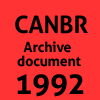 Documents relating to the history of the CANBR
Documents relating to the history of the CANBR
History of the Cryptogam Herbarium of CANBR
(Australian National Herbarium)
Written by Heinar Streimann in the introduction to 'Musci Australasiae Exsiccati', Fascicle 1, March 1992
"The Cryptogamic Herbarium of the ANBG was started in 1977 when I was asked by A.B. Court (then Curator of the Herbarium) to establish it to assist taxonomists (especially from overseas) in obtaining loans or advice regarding Australian cryptogams.
In the following year, two technical positions were created for the Cryptogamic Herbarium. I was appointed to the senior position (Technical Officer), and Doug Verdon was appointed to the other (Technical Assistant), on a part time basis. In 1991 these positions were abolished and replaced with general herbarium positions (one professional and one technical), which are currently dedicated to cryptogams.
Prior to 1977, the collection of cryptogams was a private pastime and secondary to our vascular plant duties. However, a small collection of about 10,000 cryptogams was assembled, mostly in our own time.
During February 1985 Doug retired and Judith Curnow was appointed, having assisted in the Cryptogamic Herbarium during the previous year. In the earlier years we were able to employ seasonal workers who assisted with numerous curatorial tasks.
We are now starting to build up a small group of volunteers to assist with general tasks. Heino Lepp and John A. Elix are honorary associates who assist with the fungi and the lichens respectively. Both have also donated substantial collections to the Cryptogamic Herbarium.
The aim of the Cryptogamic Herbarium is to establish and maintain a well-documented representative collection of Australian, New Guinean and other overseas, terrestrial cryptogams to fill the need for taxonomic, ecological and conservation studies. These collections will, also assist us and other researchers in our investigations of rare and endangered cryptogams.
We have developed a systematic collecting program to survey under-collected or likely threatened areas, mainly the north queensland rainforests and the temperate forests of eastern Victoria. Field studies have also included the ‘Top End’ of the Northern Territory, the Kimberley region of Western Australia, Norfolk Island and Papua New Guinea. Shorter collecting trips in New South Wales and surrounding areas are undertaken as time and finances permit. Many collecting trips are still undertaken privately. New accessions are databased and now 20 % of our collections are on database.
Presently [1992] our curated collections number over 105,000 which comprise approximately:
Mosses 50,000
Hepatics 22,000
Lichens 30,000
Fungi 3,000
Types 350
Between 6,000-8,000 collections are added each year, nearly half of which are received from a vigorous exchange program from about 40 institutions. On his retirement this year from the Deakin University in Warrnamhool, Victoria, Dr W.H. Ewers kindly donated over 8,000 lichen collections to our. herbarium. As we are continually finding species not previously reported for Australia, the foreign component of the collections is becoming a valuable identification tool. On average, 2,800 collections are sent on loan each year, and about 800 collections are received on loan for our own taxonomic program.
With the growth of the collections, space has always been a problem, and the collections were scattered in various rooms and floors in the Botany Building. However, slowly the various collections are being brought together and housed vertically in individual packets (10 x 15 cm) in permanent metal filing cabinets (178.5 cm high, 57 cm wide, 61.5 cm deep) which are 12 drawers high with 3 rows per draw. Bulky collections arc placed into boxes with the most common depth being 1.5 and 2.5 cm. The mosses and lichens are now housed in their own rooms with associated research facilities. All types are housed separately.
Visitors are always welcome and we will endeavour to assist them in their studies and field work as much as possible."
Heinar Streimann 1992
![An Australian Government Initiative [logo]](/images/austgovt_canbr_90px.gif)
